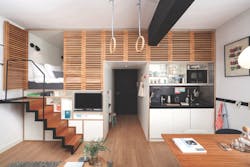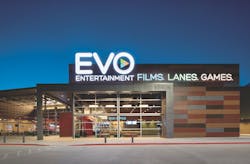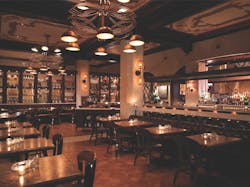Who could have guessed that food trucks and flat-screen TVs would have such an impact on the hospitality business?
Food trucks, for the local flavor and immediacy of cuisine they deliver to on-the-go customers. Flat-screen TVs, for liberating hotels from bulky furniture, freeing designers to streamline guest rooms for greater comfort and efficiency.
Toss into this mix more seismic factors—Airbnb, the outsize influence of boutique hotels, a surfeit of brands, the influx of foreign investors, and the growing importance of food and beverage offerings—and you have a hospitality sector that’s constantly searching for the next hot format, cool design flourish, or quirky amenity (memory pillows, anyone?) that will click with patrons, especially younger customers.
TOP TRENDS
1. Lobbies take center stage.
2. A brand for every personality.
3. The line between hotels and homes blurs.
4. Leaning toward technology.
5. Food & beverage is the new revenue stream.
6. Restaurants cut back on extravagance.
7. Fine dining goes down market.
8. Food service is integral at entertainment venues.
“Hospitality is a different animal from other sectors because there are so many stakeholders,” starting with consumers, says Lisa Zengerle, Principal/Director of Hospitality at SERA Architects, which has designed numerous projects for Marriott International.
“It’s not just about designing a place anymore,” states WATG|Wimberly Interiors, the Irvine, Calif.-based hospitality design firm. “It’s about designing an experience that flows from check-in to sleeping, to bathing, to dining.” Hospitality today is all about the experience, “how many times your guests say Wow!” says Chad McWhinney, CEO of Denver-based developer/property manager McWhinney, whose firm co-developed (with Sage Hospitality) the 1881 Great Hall in Denver’s Union Station.
Hospitality is strong right now. Very strong. The September 2015 STR Pipeline Report found 3,696 hotel projects and 441,397 rooms under contract in the U.S., an 11.7% increase in rooms under contract and 19.6% increase in rooms under construction over the same month a year ago.
The Census Bureau estimated that the value of construction in place for lodging in September was up 32.8% over September 2014, to an annualized volume of $16.8 billion. The “Amusement and Recreation” category, which is a growth playground for restaurant developers, was up 30.6% to $16.9 billion.
Much of the hotel boom is happening in cities. “Where our business used to be 80-20 suburban-urban, now it’s more like 50-50 urban-suburban,” says George Sorich, AIA, LEED AP, Principal, NORR Architecture, Chicago. NORR broke ground in October on a 145-room Hampton Inn with 10,000 sf of ground-floor retail, near an elevated train stop at the Loyola University Chicago campus.
Los Angeles is experiencing something of a renaissance in hotel construction, says Madelaine Fava, AECOM’s Vice President of Buildings and Places. The City of Angels is on track to double its number of hotel rooms within the next five years. That includes a lot of conversions, says Jackie Gilfilian, Director of Marketing for L.A.-based City Constructors. Her company recently overhauled a 12-story tower at the Hollywood Roosevelt Hotel, which included adding a bowling alley and bars.
In Atlanta, John Portman & Associates recently completed the Hotel Indigo Atlanta Downtown, an office-hotel redevelopment located above the city’s subway line, with 206 rooms. Guests are greeted by a 20-foot-tall skylight, a grand staircase—a Portman design signature—and a glass-canopy-topped bar near the check-in desk.
The 258-sf Zoku Loft, designed by Amsterdam-based Concrete, brings work/live/play for hotel rooms to new levels. The space includes loft-style sleeping, an alcove desk complete with office supplies, a fully equipped kitchen, and even gymnast rings. Photo: courtesy Concrete Architectural Associates
Full-service hotels are still being built, mostly overseas. The striking ME Dubai Hotel, with a futuristic interior design by architect Zaha Hadid, is scheduled to open next year in the $400 million Opus development in Dubai’s Business Bay. The so-called “figure 8” resort hotel in South Korea, which should be ready for the 2018 Olympics, will encompass 946 rooms within 317,460 sf.
But big hotels can be risky. Just ask John Hardy, Founder/CEO of CM firm John Hardy Group, Atlanta. He recalls that it took 23 years, two dozen District of Columbia Council votes, and several lawsuits before the 14-story, 1,175-room, 49-suite Marriott Marquis could open its doors. (Hardy’s firm took over during the last five years of the project.) “There’s a place for the big, full-service hotel, but a lot of them are being recycled, resold, and remade,” says Hardy.
Recent reinventions include the $175 million Intercontinental New York Barclay, which Shawmut Design & Construction is redoing. It is scheduled to open next spring with 704 guest rooms, two ballrooms, and a new lobby, restaurant, and MEP system.
In a sign of the times, Intercontinental Hotels Group last December shelled out $430 million to acquire 62 hotels and 71 restaurants, plus ultra boutique operators, from Kimpton Hotels. This marriage of opposites leads John Tobin, Shawmut’s Director of Hotels, to conclude that the hospitality sector is more than a little schizophrenic about how best to target the broadest cross-section of customers.
Let’s see what’s trending in hospitality, starting with hotels.
TRENDS IN HOTEL management,
DESIGN, AND CONSTRUCTION
1. Lobbies and public spaces take center stage.
In its 2015 Design Forecast, Gensler talked about “seen to be seen” hotel lobbies that mix work, socializing, and relaxation, and encourage what Tom Ito, AIA, LEED AP, Gensler’s Lifestyle Sector Leader, calls “collaborative consumption.”
“Lobbies and lobby bars are becoming more than just a place to wait,” says Ito. The Gensler-designed Hotel Sorella, in Houston, features a multipurpose lounge that allows for more live, work, and play options.
At New York’s Smyth Hotel, Shawmut redid the 7,900-sf public space—lobby, main entrance, and storefront, plus an interior fitout of an existing restaurant—by dividing the lobby into four sections: a living room, den, library, and evening bar. “We created spaces that aren’t traditional, that are more relaxed,” says Tobin.
He and other AEC sources note that this focus on lobbies and public spaces is a concession to younger guests, who simply don’t want to stay in their rooms. For business travelers, a more functional lobby—with reliable WiFi, plugs everywhere, and food and beverage at the ready—becomes an extension of their offices and businesses.
Luxe lobbies, especially those adorned with art, create a sense of place—“the unexpected experience that guests will talk about,” says Michael Everett, Sage Hospitality’s Chief Investment Officer.
Such is the case at The Lodges, a $7 million, 16-room modular hotel that opened last summer on Vashon Island, Wash. It features two communal spaces—the Public House and the Pavilion—that can be reserved for wedding parties, office retreats, or group functions. “Guests are looking for places that are smaller in scale and seasonal,” says Jena Thornton, Managing Director of Eagle Rock Ventures, which owns The Lodges and 17 other properties.
2. A brand for every personality.
In September, Starwood Hotels & Resorts Worldwide opened its 100th Aloft-brand hotel. The 105-room hotel, in College Station, Texas, features a 24-hour gym, 1,500 sf of flexible meeting space, and a one-stop gourmet grab-and-go food/beverage area (“re:fuel at Aloft”). It also hosts a live-music series.
Starwood operates hotels under 11 brands, from the traditional Westin and Sheraton to the W Hotels, whose success some believe triggered the hotel branding craze. NORR Architecture’s Norich thinks Hard Rock Café’s venture into hoteling set the pace. Now, he says, different brands appeal to different consumer attitudes.
By Hardy’s count, there are more than 200 hotel brands operating in the U.S. Marriott tops the list at 19. (That will go up to 30 if its recent acquisition of Starwood Hotels and Resorts is approved by regulators.) “All of them are targeting Millennials,” he laughs. “If you took away the brand name, you wouldn’t be able to tell the difference among most of them.”
Evo Entertainment’s venue in Kyle, Texas, features 14 bowling lanes, 11 movie screens, a restaurant/bar, and a 3,500-sf game room. Building Team: Beck Architecture (designer), L.A. Fuess Partners (SE), EnviroDesign (MEP), Clay Moore Engineering (CE), and Archillume (lighting consultant). Photo: Casey Dunn Photography
Brands like Nobu already have a built-in reputation. The Japanese restaurant operator, which started opening hotels in 2013, offers amenities that “take the guest’s culinary experience to a new level,” says Monica Cuervo, Vice President with WATG|Wimberly Interiors, which designed the Nobu Hotel in Cabo San Lucas, Mexico. The 201-key luxury facility will open in 2017.
“Everything is so driven by demographics and human behavior,” observes Randa Tukan, Director of Hospitality Interior Design in HOK's Toronto office. “Hotel chains are trying to slice and dice the market in so many ways.” The irony is that the coveted Millennials have shown little, if any, brand loyalty. Hardy is convinced that branding is as much about hoteliers’ ability to sell franchises as it is about market delineation. HOK’s Tukan agrees: “The chains can argue they aren’t competing against themselves.”
AECOM’s Fava says that branding and adaptive reuse go hand-in-hand because they allow developers and owners to reinvent older properties for a new set of customers.
Josh Flowers, AIA, LEED AP, General Counsel with hospitality specialist Hnedak Bobo Group, Memphis, thinks that some chains view branding as a way to protect their properties from further encroachment by Airbnb. To do that, he says, there’s got to be “more emphasis on the total experience.”
3. Home sweet hotel.
There is a blurring of the lines between hotels and homes, says HOK’s Tukan. Andrew Linwood, Head of Design for Areen Hospitality, London, recently told TravelNewsDaily.com that he’s seeing “a move to more relaxed, residential-style spaces in mainstream hotel design in the economy and mid-scale markets.”
This trend is evident in the design of Zoku Loft, a hybrid live/work space for an extended-stay hotel. In September, John Hardy Group’s annual ceremony, held in New York on Sept. 30, awarded its $10,000 Radical Innovation grand prize to this micro-apartment project in Amsterdam, designed by Concrete Architectural Associates.
The focal point of Zoku’s 258-sf loft is a big kitchen table that can be used as a work or dining area. The elevated sleeping area can be screened off for visitors. Sliding doors hide the bathroom and kitchen, and there’s ample storage space.
Hotels are also paying much greater attention to health and wellness in their amenities and food menus. “Wellness is the new luxury brand,” says Gensler’s Ito.
Luxury suites, which are becoming more common in full-service hotels, provide affluent guests with home-like experiences, albeit with a steep price tag. One HOK project, the Mandarin Oriental in New York, includes suites that go for $28,000 a night. The Palace, also in New York, offers duplex suites with outdoor hot tubs for $27,000. “These places have incredible service that anticipates needs,” says Christina Hart, Director of Hospitality Interior Design in HOK’s New York office.
HBG’s Flowers says that flexibility is the key to hotel design. For a $95 million luxury hotel next to Graceland in Memphis, the firm developed a prototype for guest rooms that can be customized during the design process. Some of the suites were designed in consultation with Priscilla Presley.
4. Leaning, ever so warily, toward technology.
For the past three years, National Commercial Builders, Lenexa, Kan., a contractor in the hospitality sector, has been moving electronic documents around via a cloud-based filing system. “Our biggest challenge is supporting the field, and this makes it easier,” says Sheldon Oxner, NCB’s president. “Digital has changed this world the same way as what Amazon has done to brick-and-mortar stores.”
Aloft Hotels recently launched SPG Keyless. Starwood claims this is the first mobile, keyless entry system: Guests use their smartphones to gain entry to their rooms. In September, Design Hotels, which represents more than 270 independent hotels in 50 countries, announced a partnership with GuestDriven, a mobile guest engagement platform, to provide mobile check-in to Design Hotels’ member properties.
But the lodging industry hasn’t jumped onto the tech bandwagon as quickly as other sectors, partly because it can’t always get its customers to come along for the ride.
“Every major brand has invested in technology, without much success,” says Hardy. Some guests remain leery, even nervous, about the security of keyless room entry, and balk at using smartphones to operate the lights and air-conditioning systems in their rooms.
Still, the trend toward technology can’t be ignored, says Rob Halverson, Vice President/Senior Project Manager for John Portman & Associates, which is looking into mobile check-in. (“We’re not there just yet,” he admits.) Eagle Rock Ventures’ Thornton says that, while younger guests may not care about brands, “They do care about technology,” as is made clear by how much they use social media to choose where they stay.
5. Food and beverage: the new revenue stream.
In late October, Europe’s largest hotel group, AccorHotels, hired a former Bain & Co. consultant, Amir Nahal, to oversee the revamping of its food and beverage offering. In 2014, F&B accounted for 25% of AccorHotels’ $13.6 billion in revenue, but produced margins that were far below Accor’s room-booking segment.
Food services, particularly restaurants, can be a headache for hotels. Some guests simply reject hotel restaurants as second rate. The economics of running a restaurant can be tricky, and most hotels don’t make money on room service, according to AEC sources.
A couple of years ago, after Shawmut redid the New York Hilton in Midtown Manhattan, Hilton eliminated room service for its 2,153 rooms and installed a self-service 24-hour restaurant, Herb & Kitchen, in its foyer. “That got people out of their rooms,” says Tobin. Hilton plans to test this concept in other markets.
“Hotels can only charge so much for rooms,” says Tobin. They have to look at F&B as more than a loss leader. In the fall, Shawmut was wrapping up work on La Sirena, chef Mario Batali’s first New York restaurant in a decade, at the Maritime Hotel. The showcase will be a trattoria with 250 indoor and outdoor seats whose menu, according to The New York Times, will evoke Little Italy.
WATG|Wimberly Interiors’ Cuervo notes that hotels seem more open to leasing space to third-party restaurateurs, to the point where patrons sometimes don’t associate the restaurant with the hotel. Sage Hospitality has a separate restaurant group that brings in what Everett calls “destination restaurants” to hotels. Local residents typically account for 80% of the restaurant’s business.
Hotel restaurants are most successful, say AEC experts and property managers, when they convey a sense of place to their customers. HOK’s Hart singles out Gallow Green, a rooftop garden and bar in New York’s McKittrick Hotel, which one reviewer on Yelp favorably compared to “something out of Alice in Wonderland.”
TOP TRENDS IN RESTAURANT
DESIGN AND CONSTRUCTION
6. Restaurants are cutting back on extravagance.
Spacecraft Design Group, Los Angeles, is one of the few design-build firms in the restaurant sector. Founder Kris Keith believes strongly that design-build is ultimately less expensive for the client and streamlines construction. It takes Spacecraft 7–12 months to complete a restaurant; Keith suggests that Building Teams using design-bid-build might need an extra six months.
Hospitality Construction Services, which has built more than 100 restaurants, mostly in the Maryland–Washington, D.C., area, is also helping clients economize through value engineering. “We generally don’t bid work,” says HCS’s Founder, Rob Mescolotto. “The mantra I’m changing about GCs is that I work for you, I’m on your staff.”
He says restaurateurs are holding down their construction budgets at a time when their patrons are looking for value on the menu. “Architects don’t know what anything costs, and I’m constantly reining in owners’ spending,” says Mescolotto.
For Raku, in Washington, D.C., Mescolotto says he saved the client $60,000 by using heart pine instead of cypress. On another project, HCS saved the restaurateur $10,000 by using gold paint instead of gold leaf.
7. Fine dining goes downmarket.
For most Americans, fine dining is still a special night out, with all the accoutrements such restaurants have to offer: exquisite table settings, choreographed wait service, stratospherically priced wine lists. But as people eat out more often, owners of fine-dining restaurants are looking to cash in by expanding their brands to attract a broader range of patrons at a somewhat lower price point.
Shawmut has built more than 300 restaurants, but hasn’t worked on a white tablecloth establishment since its fitout of the 12,000-sf Towne Stove & Spirits in Boston’s Hynes Convention Center four or five years ago. “We’re not seeing those blueprints coming through much anymore,” says Tobin. “Danny Meyer isn’t opening more Eleven Madison Parks; he’s opening Shake Shacks and Porchlight Bars.”
Tobin notes that Le Bernardin, one of America’s elite restaurants, also operates the laid-back Aldo Sohm Wine Bar, across the street from its flagship restaurant in New York. Along with its high-end Double Eagle Steak Houses, Del Frisco operates 21 Del Frisco Grilles, which Tobin says “are more casual, louder, have a different menu but still quality food.”
Tobin also points to chef Michael Schlow, who once operated the top French and Italian restaurants in Boston. Schlow closed both of these spots and then opened Latin-themed restaurants (under the name Tico) in Boston and Washington, D.C. Schlow has developed a similar brand, Alta Strada, for Italian cuisine.
8. Grab a bite, catch a flick, pick up a spare.
Hospitality customers are looking for variety, which can mean a lot of different things for restaurants. Mescolotto notes that one of the Black Jack Restaurant Group’s bars in D.C. has a bocce court fitted out with 19 stadium seats for viewing.
Restaurants are finding new life as components of entertainment venues. Last November, the startup EVO Entertainment opened a 70,000-sf facility in Kyle, Texas, with an 11-screen cinema, 14-lane bowling center, full-service restaurant/bar, and a 3,500-sf game floor. Its Principal, 20-year-old Mitchell Roberts, is the scion of the family behind Texas Cinema and the Cinemark Theater chain.
Jeffrey Hill, AIA, a Principal with The Beck Group’s architecture practice in Dallas, which designed EVO’s inaugural location, says that one of the project’s objectives was to “let customers see all what the facility has to offer at the entrance.” There’s lots of glass inside the building, which may spur a bowler, say, to also catch a movie or a meal.
Food and beverage is fast becoming a staple at movie theaters. Cobb Theaters has opened 23 Cinebistros, a concept that combines theaters and restaurants. AMC Theaters has several formats—Fork & Screen, Cinema Suites, Red Kitchen, MacGuffin’s Bar & Lounge—that offer varying levels of F&B service.
In September, Studio Movie Grille, a full-service, in-theater dining chain, opened its 23rd location, a 41,311-sf theater with nine auditoriums. It’s all part of a 628,000-sf outdoor shopping, dining, and entertainment destination in Simi Valley, Calif.
“Almost all of the theaters we’ve worked on lately have a restaurant component,” says National Commercial Builders’ Oxner. He says that changing viewer habits have left many theaters with too many screens. So theater operators are looking for ways to fill their auditorium spaces. New theaters almost always have a second or third non-movie element, Oxner says.
Oxner has been working with Brunswick Corporation to put bowling alleys in movie theaters. Frank Entertainment Companies has jumped on the 10-pin bandwagon. Its CineBowl Grille and Revolution concepts, which range from 35,000 to 55,000 sf, offer 20 to 24 bowling lanes and full-service restaurants.
“The days of the snack bar are dead,” says Oxner.
Now even driving ranges are combining the sport with food. Top Golf, the family-oriented driving range chain, opened a 65,000-sf facility in Overland Park, Kan., that has been drawing as many as 10,000 guests (mostly non-golfers) on the weekends. Guests can order food and beverages while they play; 90% of the food is prepared from scratch every day. Top Golf ended 2015 with 21 locations.




